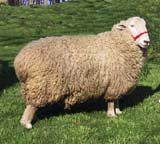Coopworth sheep facts for kids
The Coopworth is a special type of sheep that was created in New Zealand. Scientists at Lincoln University in Canterbury developed this breed. Their main goal was to help Romney ewes (female sheep) have more lambs when they mated with Border Leicester rams (male sheep).
Coopworths are now the second most common sheep in New Zealand. You can also find them in Australia, parts of Europe, and the United States. These sheep are useful for two main things: their meat and their wool. An average Coopworth fleece (the wool from one sheep) weighs about 5 kilograms (11 pounds). Their wool fibers are quite thick, about 30 to 35 microns wide, and can be 125 to 200 millimeters (5 to 8 inches) long. An adult Coopworth sheep usually weighs around 55 kilograms (121 pounds).
Contents
How the Coopworth Sheep Was Developed
Scientists in New Zealand started studying sheep breeding in the 1950s. They noticed that New Zealand sheep weren't having enough lambs. They wanted to find a way to increase the number of lambs born. They knew that Border Leicester sheep were very fertile, meaning they could have many lambs.
Early Breeding Experiments
Researchers at Lincoln College began experiments by crossing Border Leicester rams with Romney ewes. They found that the first generation of these crossbred ewes had 15–30% more lambs than the original Romney ewes. This was a great improvement!
Creating a New Breed
These good results led to a new idea. Could they breed these crossbred sheep together to create a completely new, stable breed? This new breed would keep the good traits of the first cross, especially the high fertility.
Scientists at Lincoln College focused on selecting sheep that were very fertile. They compared the new generations to the original Romney sheep. Even though there was a small dip in fertility in the second and third generations, the new sheep still had many more lambs than the Romneys.
Forming the Coopworth Society
Some farmers who were also interested in this new type of sheep continued to breed them. They focused on selecting the most fertile animals. By the late 1960s, they believed they had a high-performing sheep that kept the best traits of the Border Leicester-Romney cross.
In November 1963, a group of these interested people met. They decided to form a society to manage the new breed. After voting on several names, they chose "Coopworth." The New Zealand Coopworth Sheep Society now sets the standards for selecting and registering these sheep based on their performance.
What Makes Coopworth Sheep Special?
Coopworth sheep are a medium-sized breed known for two main purposes: producing both meat and wool. They are usually calm and easy to handle.
Physical Traits
- Face and Head: They have a long face that is usually clean (without wool). They might have a small tuft of wool on top of their head or be completely bare-headed. Their nose is slightly curved, often called a "Roman nose."
- Body Shape: Coopworths stand a bit taller than New Zealand Romney sheep. They have stronger muscles than Border Leicester sheep. Their body is long, with a good loin (back) and hindquarters (rear). They have a wide pelvis, which helps with lambing.
- Wool: Their wool has pointed locks and a clear crimp (waves). It has a bright shine. The wool fibers are about 35–39 micrometers thick, and the staple length (how long the wool grows) is about 15–20 centimeters (6–8 inches).
- Colors: In New Zealand and Australia, only white Coopworths can be officially registered. However, in the United States and Canada, both white and naturally colored Coopworths can be registered.
Easy Lambing and Good Mothers
One of the best things about Coopworth ewes is how easily they give birth. Very few need help during lambing. This is because their pelvis is shaped well, and their lambs have narrower heads and shoulders.
Coopworths are also excellent mothers. They have a strong mothering instinct and don't run away if disturbed. They produce a lot of milk, which helps their lambs grow strong. All these traits make lambing easier for farmers, require less work, and lead to more lambs surviving, even when there are many twins. Farmers often say that caring for Coopworths during lambing takes less than half the effort needed for other breeds like Romneys or Corriedales.
Other Helpful Traits
- Easy to Muster: Coopworths are easy to gather, even in rough or bushy areas. This might be because of their clear faces and longer legs.
- Fast Growth: Young Coopworth sheep grow quickly. This means they are easier to raise and reach market size sooner.
It's important to know that Coopworths might look a bit different from each other. This is because breeders focus on their performance (like how many lambs they have or how much wool they produce) rather than just their looks. So, different wool styles, similar to Border Leicester and New Zealand Romney types, are acceptable.
Coopworths in the United States
The first Coopworth sheep arrived in the United States in the 1970s. Jonathan May and Don Gnos were among the first to import them. Later, in 1980, Woodsedge Wools brought in 10 pregnant ewes. Other importers included Jan and Trudy Van Stralen from Canada. Today, importing live sheep is very expensive due to quarantine rules. Because of this, breeders often use Artificial Insemination (AI) to bring new Coopworth genetics into the country.
The American Coopworth Registry
The American breed registry for Coopworth sheep is called The American Coopworth Registry. This group helps all owners and breeders of Coopworth sheep. Their goals are to protect and improve the breed and to teach their members. The Registry officially registers all eligible white and natural-colored Coopworth sheep that meet the breed's standards. They also provide support and education to their members. They have an online directory of members and products, a quarterly newsletter, and a marketplace on their website where members can advertise their sheep for sale.


